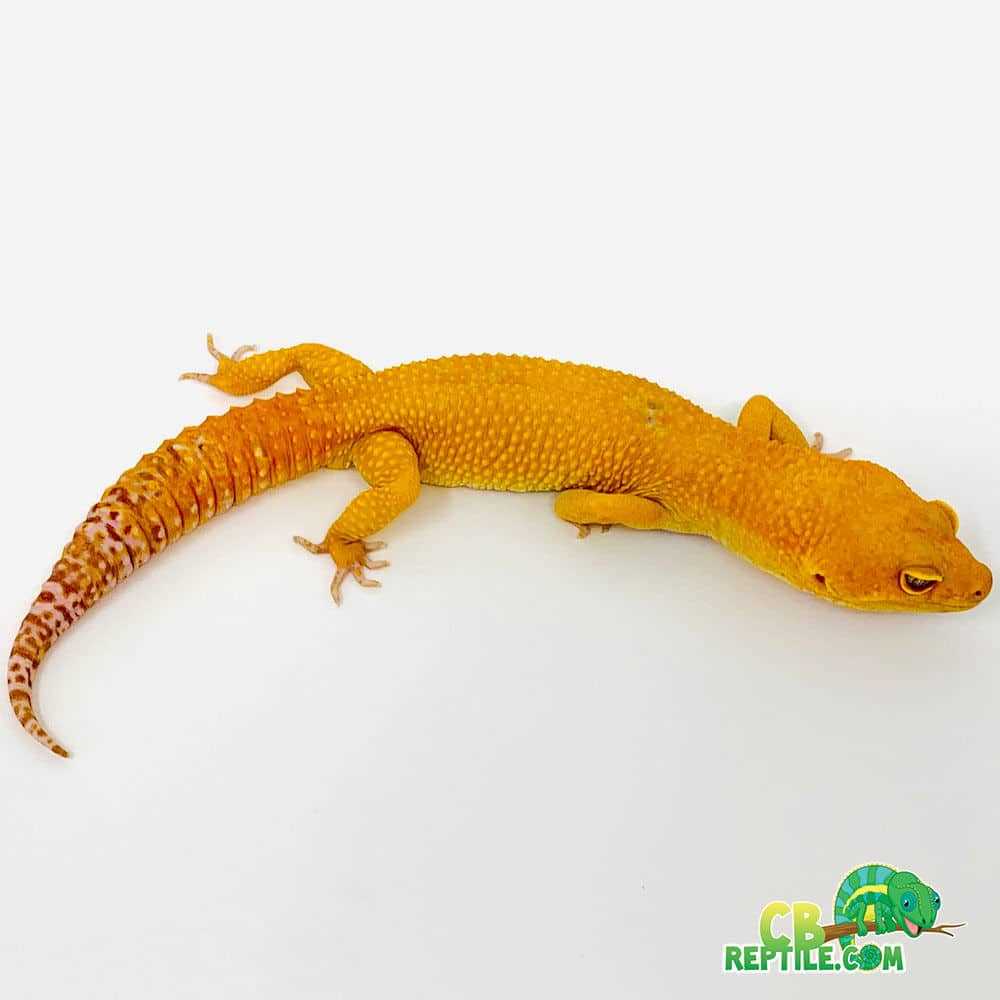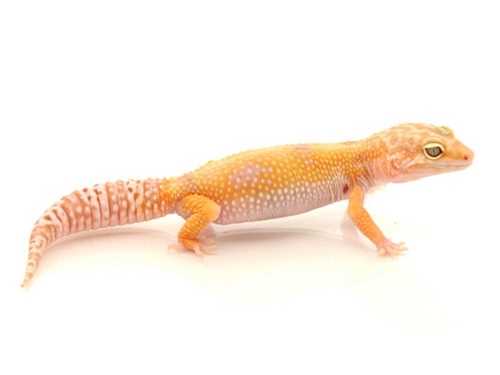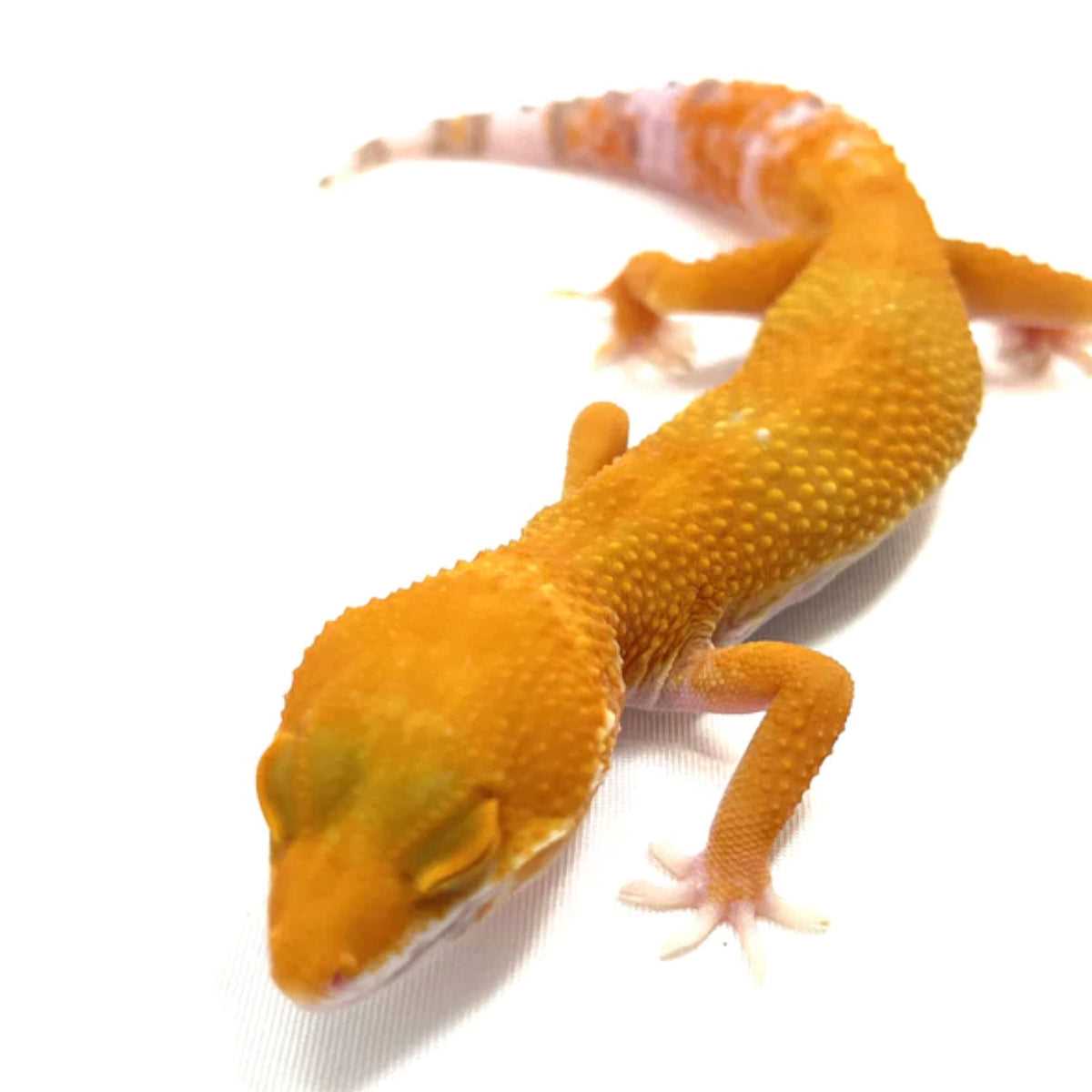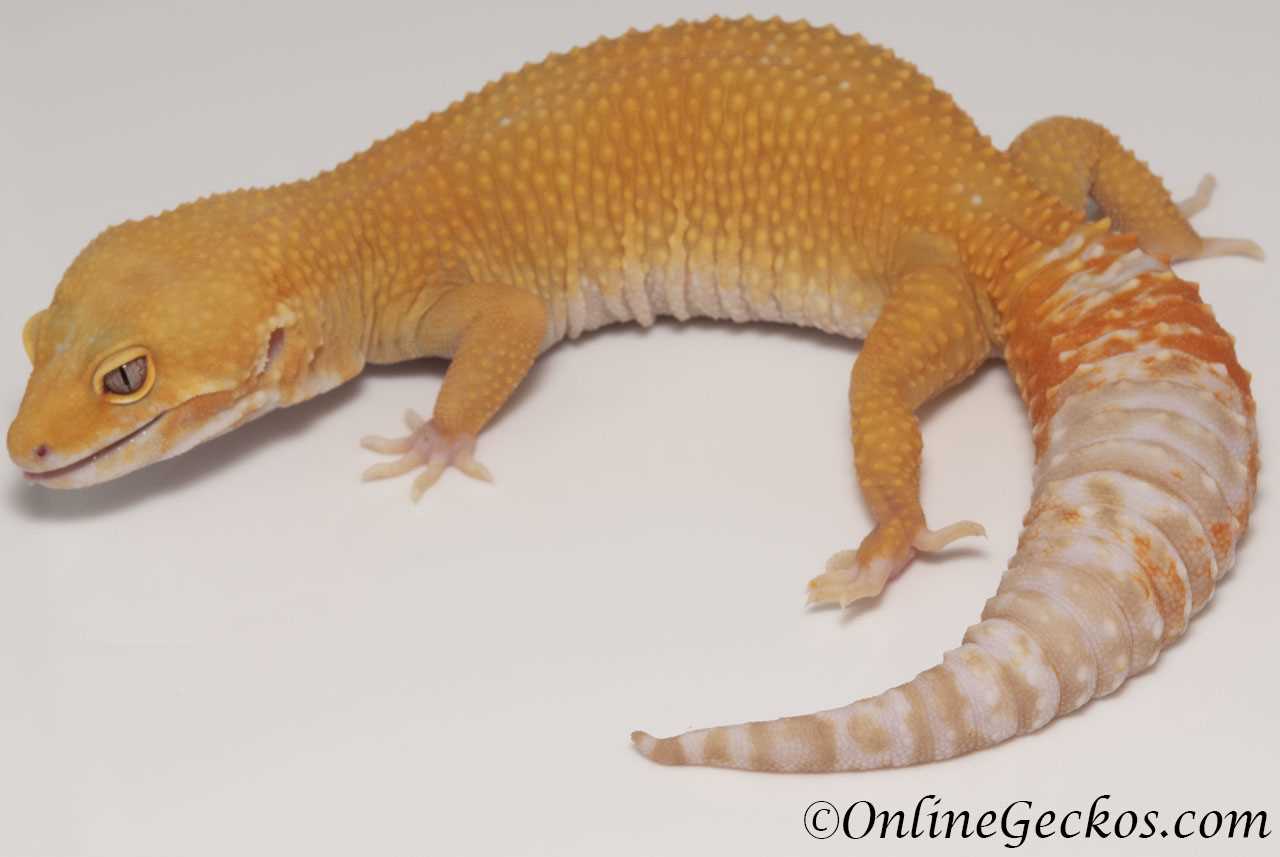Leopard geckos are one of the most popular pet lizards due to their small size, docile nature, and ease of care. Among the various morphs of leopard geckos, the sunglow morph is particularly striking. With its vibrant colors and unique albino characteristics, the sunglow leopard gecko is a favorite among reptile enthusiasts.
The sunglow morph is the result of breeding two different leopard gecko morphs: the albino and the hypo melanistic. This combination produces a lizard with a bright yellow or orange body, devoid of any dark pigmentation. The absence of dark pigment in the skin gives the sunglow leopard gecko its distinctive appearance, making it a sought-after addition to any reptile collection.
When caring for a sunglow leopard gecko, it is essential to provide the right habitat and diet. Just like other leopard geckos, sunglows require a warm and well-maintained enclosure with proper lighting, heating, and substrate. Their diet mainly consists of insects, such as crickets and mealworms, supplemented with calcium and multivitamin powder.
Sunglow Leopard Gecko: The Ultimate Care Guide
Leopard geckos are fascinating and popular reptile pets known for their colorful and unique morphs. One such morph that captivates many reptile enthusiasts is the Sunglow Leopard Gecko. As its name suggests, the Sunglow morph displays vibrant and intense colors, making it a standout in any gecko collection.
The Sunglow Leopard Gecko is a result of selective breeding, combining the traits of several morphs to produce an incredibly beautiful lizard. This morph is characterized by its brilliant golden-yellow body coloration with bold, contrasting markings along its back and sides. The eyes of the Sunglow gecko are also strikingly vibrant and appear almost red or orange, further enhancing its overall appearance.
Housing and Environment
Providing the ideal habitat for your Sunglow Leopard Gecko is crucial to its well-being and overall health. As with any leopard gecko, a proper housing setup should include a spacious enclosure with ample room for your gecko to move around and explore. A 20-gallon tank is generally sufficient for a single adult Sunglow gecko.
The enclosure should be equipped with a secure lid to prevent escape, as well as proper heating and lighting sources. A temperature gradient should be maintained within the tank, with a hot spot of around 90°F (32°C) at one end and a cooler side around 75°F (24°C). This allows your gecko to regulate its body temperature according to its needs.
Feeding and Nutrition
Always provide a shallow dish of water in the enclosure to ensure your gecko stays hydrated. Fresh water should be provided daily, and the dish should be cleaned regularly to prevent the growth of bacteria.
Health and Wellness
Proper care and attention to your Sunglow Leopard Gecko’s health are essential for its long-term well-being. Regularly observe your gecko for any signs of illness, such as loss of appetite, lethargy, changes in stool appearance, or abnormal shedding. It is essential to provide regular veterinary check-ups and consult a reptile veterinarian if you notice any concerning symptoms.
Maintaining clean and hygienic conditions within the enclosure is crucial to preventing common health issues, such as respiratory infections or parasitic infestations. Regular spot-cleaning of feces and uneaten prey items is necessary, and a complete enclosure cleaning should be done periodically.
Conclusion
The Sunglow Leopard Gecko is a stunning and beautiful morph, renowned for its vibrant colors and unique markings. Providing proper care, a suitable habitat, and a balanced diet are key to ensuring the health and happiness of your Sunglow gecko. With the right care and attention, this captivating lizard can thrive and bring joy to any reptile enthusiast’s life.
Housing and Environment: Creating the Ideal Habitat
Enclosure
For a single Sunglow Leopard Gecko, a 20-gallon tank is sufficient, but if you plan on housing multiple geckos, you will need a larger enclosure. The tank should have a secure lid to prevent any escapes, as leopard geckos are excellent climbers.
It is recommended to use a glass tank rather than a plastic one, as glass provides better ventilation. The tank should also be escape-proof, with no gaps or openings that the gecko can squeeze through.
Substrate
Temperature and Lighting

Leopard geckos are ectothermic, which means they rely on external sources of heat to regulate their body temperature. To create a suitable temperature gradient in the tank, provide a heat mat or under-tank heater on one side and a cooler area on the other side.
The warm side of the tank should have a temperature of around 88-90°F (31-32°C), while the cool side should be around 75-80°F (24-27°C). It is essential to use a thermostat with the heat source to prevent overheating.
Leopard geckos also require a light source, but they do not need UVB lighting like some reptiles. A simple low-wattage light bulb can be used to provide a day-night cycle for the gecko.
Hideouts and Decorations
Leopard geckos are nocturnal and prefer dark, secluded spaces to hide during the day. Provide multiple hiding spots in the tank, such as caves, rocks, or commercially available hideouts. These hiding spots will not only make the gecko feel safe but also help regulate their body temperature.
In addition to hideouts, you can also add some decorations to the tank, such as fake plants or branches, to create a more appealing and natural-looking habitat for your gecko.
Remember to clean the tank regularly to maintain a healthy and hygienic environment for your Sunglow Leopard Gecko. Remove any uneaten food or waste promptly, and replace the substrate as needed.
By creating an ideal habitat for your Sunglow Leopard Gecko, you will provide them with a comfortable and stimulating environment, ensuring their overall well-being and happiness.
Feeding and Nutrition: Providing the Right Diet
1. Food: The sunglow leopard gecko is an insectivorous lizard, which means its diet mainly consists of insects. The primary food sources for a sunglow leopard gecko include crickets, mealworms, silkworms, and dubia roaches. These insects not only provide essential nutrients but also fulfill the gecko’s natural instinct to hunt and forage.
2. Gut-Loading: It is essential to provide gut-loaded insects to the sunglow leopard gecko. Gut-loading involves feeding the insects a nutritious diet before offering them to the gecko. This ensures that the gecko receives a more nutrient-rich meal. Gut-loading can be achieved by providing the insects with fruits, vegetables, and commercial insect diets for a day or two before feeding them to the gecko.
3. Supplementation: Along with a varied insect diet, supplementation is necessary to ensure the sunglow leopard gecko receives all the essential vitamins and minerals. Calcium and vitamin D3 are particularly crucial for maintaining strong bones and preventing metabolic bone disease. These supplements can be dusted onto the insects before feeding them to the gecko. However, it is essential to follow dosage guidelines to prevent over-supplementation.
4. Feeding Schedule: Sunglow leopard geckos are nocturnal creatures and prefer to eat during the evening and night hours. It is best to provide food when the gecko is most active, typically a couple of hours after dusk. Offering a few appropriately sized insects 2-3 times a week is usually sufficient. However, it is essential to monitor the gecko’s body condition and adjust the feeding schedule accordingly.
5. Water: Access to clean and fresh water is crucial for the sunglow leopard gecko. A shallow water dish should be provided in their enclosure, allowing them to drink whenever they need to. It is essential to clean and refill the water dish regularly to prevent the growth of bacteria and algae.
6. Observation: While feeding the sunglow leopard gecko, it is essential to monitor their eating habits. If the gecko shows signs of loss of appetite, weight loss, or irregular bowel movements, it may indicate an underlying health issue. In such cases, it is recommended to consult a reptile veterinarian for proper diagnosis and treatment.
Providing the right diet to a sunglow leopard gecko is vital for its overall well-being and longevity. By following the proper feeding practices and ensuring proper nutrition, you can keep your gecko healthy, active, and vibrant with its beautiful albinism and colorful morph.
Health and Wellness: Preventing and Treating Common Issues
Common Health Issues
While Sunglow leopard geckos are generally hardy pets, they can still experience certain health problems. Some of the most common issues include:
| Health Issue | Symptoms | Treatment |
|---|---|---|
| Respiratory Infections | Coughing, wheezing, mucus discharge | Veterinary diagnosis and prescribed antibiotics |
| Parasites | Weight loss, diarrhea, presence of visible parasites | Veterinary diagnosis and prescribed antiparasitic medication |
| Mouth Rot | Swollen or discolored mouth, difficulty eating | Veterinary diagnosis and cleaning of the mouth, possible antibiotic treatment |
Prevention Measures
Preventing common health issues in Sunglow leopard geckos is essential for their overall well-being. Here are some preventive measures to follow:
- Maintain a clean and hygienic enclosure by regularly cleaning and disinfecting all surfaces.
- Ensure your gecko’s habitat is at the proper temperature and humidity levels to prevent respiratory issues.
- Provide a balanced diet consisting of live insects and vitamin supplements to avoid nutritional deficiencies.
- Quarantine new geckos before introducing them to an existing population to prevent the spread of diseases.
- Monitor your gecko’s behavior and appetite daily to spot any signs of illness or abnormalities.
Treating Common Issues

Breeding and Reproduction: Successfully Raising Sunglow Leopard Geckos
Creating the Ideal Environment
Temperature and humidity also play crucial roles in successful reproduction. Maintaining a temperature range of 82-88°F (28-31°C) during the day and a slight drop to 75-80°F (24-27°C) at night is recommended. Humidity levels should be kept around 40-50% to prevent any respiratory issues.
Mating and Egg Depositing
Female Sunglow Leopard Geckos typically lay their eggs approximately 20-30 days after mating. Provide a suitable egg-laying container filled with moist vermiculite or perlite for the female to deposit her eggs. The container should be placed in a secure and warm location to promote successful incubation.
Incubation and Hatching

After the eggs are laid, they should be carefully transferred to an incubation container with the same vermiculite or perlite substrate. The temperature inside the incubator should be maintained at a constant 82-88°F (28-31°C) for optimal development.
The eggs will hatch after an average of 45-60 days. During this time, it’s crucial to regularly check the temperature and humidity levels within the incubator to ensure proper conditions for successful hatching. Once the geckos have hatched, they should be kept in a separate enclosure to avoid any cannibalism.
Caring for the Hatchlings
Regularly monitor the temperature and humidity levels in their new enclosure and make any necessary adjustments to ensure their health and well-being. It is also recommended to separate the male and female hatchlings to prevent early breeding.
Morphs and Colors: Exploring the Beautiful Variations
Leopard geckos are well-known for their stunning array of morphs and colors. One particular morph that stands out is the Sunglow Leopard Gecko. This morph exhibits a vibrant, golden coloration that is truly eye-catching.
Morphs in general are genetically determined variations in appearance within a species. They occur naturally due to genetic mutations and can also be selectively bred for specific traits. The Sunglow Leopard Gecko is a result of breeding for the recessive albinism trait.
Albinism is a condition that affects the production of pigmentation in animals. In the case of the Sunglow Leopard Gecko, the absence of melanin pigment results in their unique golden coloration. This morph is highly sought after among reptile enthusiasts and is considered a prized addition to any gecko collection.
The Sunglow morph is a combination of two recessive traits: albinism and hypo. Albinism causes the absence of melanin, resulting in a lack of pigmentation in the skin, eyes, and scales. Hypo, short for hypomelanistic, reduces the amount of melanin produced, leading to lighter hues and a washed-out appearance.
Other Popular Leopard Gecko Morphs

- Tangerine: characterized by vibrant orange coloration
- Halloween Mask: featuring striking patterns resembling a Halloween mask
- Super Snow: exhibiting a pure white appearance
- Mack Snow: displaying a darker, speckled pattern
Each morph has its own unique charm and appeal, making leopard geckos one of the most diverse and visually captivating reptile pets available.
If you’re considering getting a leopard gecko as a pet, exploring the various morphs and colors can be an exciting journey. Whether you choose a Sunglow, Tangerine, or any other morph, caring for these beautiful creatures will undoubtedly bring joy and fascination to your life.

I’m Lena Adams—a product of an unconventional upbringing in the African wilderness. My father, a daring explorer of African wildlife, sparked my fascination with reptiles, a passion that intertwined with the tragic loss of my mother during an expedition, leaving an indelible mark on my life. Driven to understand the creatures that captivated my parents, I embarked on my journey, sharing insights about reptiles, frogs, and lizards on my website. Through my explorations and conservation efforts, I honour my family’s legacy while seeking connections—to the creatures, nature, and the mother whose presence I yearn to understand.
